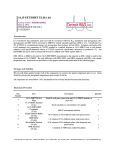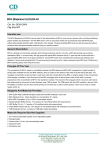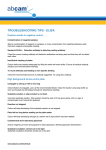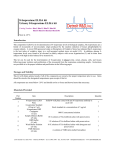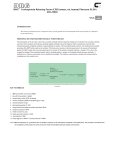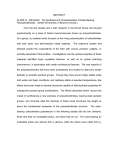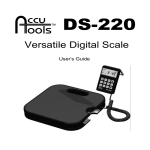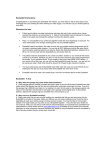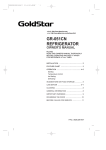Download ab175818 – 20 HETE / beta glucuronidase ELISA Kit
Transcript
ab175818 – 20 HETE / beta glucuronidase ELISA Kit Instructions for Use A competitive immunoenzymatic assay for the quantitative measurement of 20 HETE / beta glucuronidase in urine, serum, plasma, cells and tissues. This product is for research use only and is not intended for diagnostic use. Table of Contents INTRODUCTION 1. BACKGROUND 2. ASSAY SUMMARY 2 3 GENERAL INFORMATION 3. 4. 5. 6. 7. 8. PRECAUTIONS STORAGE AND STABILITY MATERIALS SUPPLIED MATERIALS REQUIRED, NOT SUPPLIED LIMITATIONS TECHNICAL HINTS 4 4 4 5 5 6 ASSAY PREPARATION 9. 10. 11. 12. REAGENT PREPARATION STANDARD PREPARATION SAMPLE COLLECTION AND STORAGE PLATE PREPARATION 7 8 9 14 ASSAY PROCEDURE 13. ASSAY PROCEDURE 15 DATA ANALYSIS 14. 15. 16. CALCULATIONS TYPICAL DATA ASSAY SPECIFICITY 16 17 18 RESOURCES 17. TROUBLESHOOTING 18. NOTES 19 21 Discover more at www.abcam.com 1 INTRODUCTION 1. BACKGROUND Abcam’s 20 HETE / beta glucuronidase competitive in vitro ELISA (Enzyme-Linked Immunosorbent Assay) kit is designed for the determination of free and glucuronidated 20 HETE (also known as 20OH-AA) levels in biological samples. The specificity of the 20 HETE ELISA was investigated using authentic 20 HETE and a panel of fatty acids which, based on their structure, might be anticipated to compete with 20 HETE for binding to antibodies for 20 HETE. Anti-20 HETE did not cross-react with 14,15- and 11,12-DHETs, PGE2 and showed almost no cross-reactivity even with structurally extremely similar arachidonic acid (AA), linoleic acid and linolenic acid as shown in the competitive ELISA analysis. Considering the only difference between 20 HETE and AA is an oxygen molecule, the specificity of this kit is a surprise. Human essential and salt-sensitive hypertensions were related to differential AA metabolism by cytochrome P450 (CYP) 4A which has AA-ω-hydroxylase (20 HETE synthesis) activity. Increased circulating insulin inhibits 20 HETE synthesis in obese hypertensive subjects. Recently, CYP4F2 genetic variants, which increased urinary 20 HETE secretion, were found to be correlated with the risk for hypertension in a Chinese population. This kit can be used for the determination of free 20 HETE and glucuronidated 20 HETE in serum, plasma, cells and tissues following proper isolation and purification. Discover more at www.abcam.com 2 INTRODUCTION 2. ASSAY SUMMARY Prepare all reagents and samples as instructed. Add standards and samples to each well used. Add prepared HRP conjugate to each well and incubate at room temp. Add TMB substrate to each well. Incubate at room temperature. Add Stop Solution to each well. Read immediately. Discover more at www.abcam.com 3 GENERAL INFORMATION 3. PRECAUTIONS Please read these instructions carefully prior to beginning the assay. All kit components have been formulated and quality control tested to function successfully as a kit. Modifications to the kit components or procedures may result in loss of performance. 4. STORAGE AND STABILITY Store kit at 2-8°C or -20°C immediately upon receipt. Refer to list of materials supplied for storage conditions of individual components. Observe the storage conditions for individual prepared components in section 9. Reagent Preparation. 5. MATERIALS SUPPLIED 96 Wells Storage Condition (After Preparation) -20°C 2 µL -20°C 1,000X 20 HETE HRP Conjugates 12 µL -20°C 10X Sample Dilution Buffer 25 mL -20°C HRP Buffer 15 mL -20°C 10X Wash Buffer Solution 25 mL -20°C TMB Substrate 24 mL -20°C Beta-glucuronidase enzyme (8mg) 1 vial -20°C Item 20 HETE ELISA Plate 20 HETE Standard (1 mg/mL) Discover more at www.abcam.com Amount 4 GENERAL INFORMATION 6. MATERIALS REQUIRED, NOT SUPPLIED These materials are not included in the kit, but will be required to successfully utilize this assay: 1 M Citric Acid 2N Sulfuric Acid Storage bottles Costar cluster tubes (1.2 mL) and microcentrifuge tubes Deionized water 7. LIMITATIONS ELISA kit intended for research use only. Not for use in diagnostic procedures Use only clean pipette tips, dispensers, and lab ware Do not interchange screw caps of reagent vials to avoid crosscontamination Close reagent vials tightly immediately after use to avoid evaporation and microbial contamination After first opening and subsequent storage check conjugate and control vials for microbial contamination prior to further use To avoid cross-contamination and falsely elevated results pipette patient samples and dispense conjugate, without splashing, accurately to the bottom of wells Discover more at www.abcam.com 5 GENERAL INFORMATION 8. TECHNICAL HINTS Avoid foaming or bubbles when mixing or reconstituting components Avoid cross contamination of samples or reagents by changing tips between sample, standard and reagent additions Ensure plates are properly sealed or covered during incubation steps Complete removal of all solutions and buffers during wash steps is necessary for accurate measurement readings Addition of the TMB Substrate solution initiates a kinetic reaction, which is terminated by the addition of the Stop Solution. Therefore, the TMB Substrate and the Stop Solution should be added in the same sequence to eliminate any time deviation during the reaction It is important that the time of reaction in each well is held constant for reproducible results. Pipetting of samples should not extend beyond ten minutes to avoid assay drift. If more than 10 minutes are needed, follow the same order of dispensation. If more than one plate is used, it is recommended to repeat the dose response curve in each plate The incomplete or inaccurate liquid removal from the wells could influence the assay precision and/or increase the background This kit is sold based on number of tests. A ‘test’ simply refers to a single assay well. The number of wells that contain sample, control or standard will vary by product. Review the protocol completely to confirm this kit meets your requirements. Please contact our Technical Support staff with any questions Discover more at www.abcam.com 6 ASSAY PREPARATION 9. REAGENT PREPARATION Equilibrate all reagents, samples and controls to room temperature (18-25°C) prior to use. 9.1 Dissolve 8 mg of beta-glucuronidase in 8 mL of 1 M citric acid, adjust to pH 5.5. 9.2 1X Wash Buffer Mix the 10X Wash Buffer Solution with a stir bar, applying low, gentle heat until a clear colorless solution is obtained. Dilute the entire contents of the 10X Wash Buffer Solution (25 mL) with 225 mL of deionized water to yield a final volume of 250 mL of 1 X Wash Buffer. This can then be refrigerated for the entire life of the kit. 9.3 1X HRP Conjugate Dilute 1 vial of the 20 HETE-HRP conjugate (12 µL) with 12 mL of HRP Buffer. One vial makes enough conjugate for one plate. The conjugate must be used the same day and should not be stored for later use. 9.4 1X Sample Dilution Buffer Prepare 1X Sample Dilution Buffer by adding 25 mL of 10X Sample Dilution Buffer to 225 mL of dH20. Mix gently and thoroughly. Discover more at www.abcam.com 7 ASSAY PREPARATION 10. STANDARD PREPARATION Prepare serially diluted standards immediately prior to use. Always prepare a fresh set of positive controls for every use. 10.1 Label 5 microtubes as Standard # 2 - 6. 10.2 Add 900 µL of the 1X Sample Dilution Buffer to the microtubes for Standards # 2 to 6. 10.3 Prepare a 1 µg/mL Standard #1 by first spinning down the enclosed 20 HETE standard vial (2 μL, filled with inert gas) and then adding 1.998 mL of 1X Sample Dilution Buffer to obtain 2 mL of solution. 10.4 Prepare Standard #2 by adding 100 µL of the Standard #1 to the microtube labeled Standard #2. Mix thoroughly and gently. 10.5 Prepare Standard #3 by adding 100 µL of the Standard #2 to the microtube labeled Standard #3. Mix thoroughly and gently. 10.6 Using the table below as a guide, repeat for tubes #4 through #6. 10.7 Standard Bo contains no protein and is blank control. Standard # Sample Dilute to 1 2 3 4 5 6 Bo Step 10.3 Standard #1 Standard #2 Standard #3 Standard #4 Standard #5 None Volume to Dilute (µL) 100 100 100 100 100 Discover more at www.abcam.com Volume of Diluent (µL) Starting Conc. (pg/mL) Final Conc. (pg/mL) 900 900 900 900 900 900 1,000,000 100,000 10,000 1,000 100 - 1,000,000 100,000 10,000 1,000 100 10 - 8 ASSAY PREPARATION 11. SAMPLE COLLECTION AND STORAGE There are different protocols for isolating and purifying free 20 HETE depending on the medium in which it is in. Listed below are the different protocols for sample preparation. For optimal results follow the appropriate protocol based on the biological sample present. 11.1 20 HETE measurement in cells expressing Cytochrome P450 4A 11.1.1 Collect and homogenize and/or sonicate the cells using a solution containing a final concentration of ~0.1 mM TPP (triphenylphosphine, 0.03-0.05 mg/mL). TPP is an antioxidant, which looks like a precipitate in samples because it does not easily dissolve. Before using the stored samples containing TPP, spin samples to separate the precipitated TPP from sample solution. 11.1.2 Acidify the whole homogenized cells with acetic acid to a pH of approximately 3-4. Measure using standard pH paper. Discover more at www.abcam.com 9 ASSAY PREPARATION 11.1.3 Extraction with ethyl acetate. Add an equal volume of ethyl acetate to the homogenized cells and vortex very well. Place the upper organic phase into a fresh clean tube after centrifugation. Then add another equal volume of ethyl acetate to the homogenized cells to start the second-time extraction. It is strongly recommended that extraction is performed three times. 11.1.4 Evaporate the pooled ethyl acetate from the extractions until all has dried up under argon or nitrogen gas. 11.1.5 Saponification if needed (see below) 11.1.6 Add 20 μL ethanol, or N, N-dimethyl-formamide (DMF), to dissolve the dried-up residue for reconstitution. Add 0.5 mL of 1x Sample Dilution Buffer (provided in kit) to make a solution. Load 100 μL in each well, in triplicates, on the ELISA plate. (Note: We recommend measuring a different dilution of sample in attempt to fit the results to the standard curve. e.g., load 3 wells with 50 μL of the rest of sample plus 50 μL of 1x Sample Dilution Buffer, and 3 wells with 10 μL of the rest of sample plus 90 μL of 1x Sample Dilution Buffer.) 11.1.7 Perform the ELISA for 20 HETE (according to the instructions of the manufacturer). 11.2 Saponification (to cleave fatty acid from glycerol backbone): 11.2.0 Dissolve dried fatty acids (obtained from 3X ethyl acetate extractions) in 2 mL of 20% KOH solution (make working solution: 1 mL of 2 M KOH + 4 mL methanol so that the final conc. of KOH = 0.4 N). 11.2.1 Vortex and incubate for 1 h at 50°C. Discover more at www.abcam.com 10 ASSAY PREPARATION 11.2.2 Add 1.5 X H2O to the solution and adjust pH with 20% formic acid to pH~5. 11.2.3 Re-extract the solution with ethyl acetate (1 part aqueous solution + 1 part ethyl acetate) and dry. 11.3 20 HETE measurement in tissues 11.3.1 Homogenize 1 g or less of tissue, 4 mL of H2O, and 0.01mg TPP. 11.3.2 Acidify the homogenate by adding 8 μL of acetic acid to each homogenate. 11.3.3 Extract with an equal amount of ethyl acetate, vortex thoroughly, spin down, and collect the organic phase. Repeat this extraction twice more and combine all of the organic phases. 11.3.4 Dry the organic phase with argon or nitrogen gas. 11.3.5 Saponification if needed (see Section 11.2) 11.3.6 Dissolve the dried residue from above step with ethanol or DMF. (Add approximately 20 μL of ethanol or DMF to reconstitute the dried-up residue.) 11.3.7 Dilute further with 1X Sample Dilution Buffer: Add approximately 500 µL of 1x Sample Dilution Buffer and centrifuge at 10,000 rpm for five minutes at room temperature. The supernatant will be used for ELISA. 11.3.8 Perform the ELISA for 20 HETE. 11.4 20 HETE measurement in plasma or serum 11.4.1 Combine 1.8 mL of plasma (adjusted with approximately 20 μL of acetic acid to pH 4) and 1.8 mL of ethyl acetate. Vortex thoroughly. Centrifuge at 2000 rpm for ten minutes at 22°C. Three phases should result: Discover more at www.abcam.com 11 ASSAY PREPARATION 11.4.1.1 Upper organic phase – ethyl acetate phase (lipoproteins) 11.4.1.2 Interphase – proteins 11.4.1.3 Lower phase – aqueous phase 11.4.2 Collect the upper organic phase (a) and set aside. 11.4.3 Discard the interphase. Transfer the lower phase with a glass pipette to a new tube, and repeat the ethyl acetate extraction step 2 more times. 11.4.4 Evaporation of pooled organic phase: There should be approximately 3 mL of the ethyl acetate phase (a). Dry the pooled organic phase in a Speedvac to get the extracted sediment (b). 11.4.5 Saponification (to cleave fatty acid from glycerol backbone): Dissolve the dried residues (b) in 2 mL of 20% KOH solution (for preparation see 20 HETE measurement in cells). Vortex thoroughly and incubate for 1 h at 50°C. This will yield an aqueous solution (c). 11.4.6 Dilute 2 mL of the aqueous solution (c) with 3 mL of H2O. Adjust the pH using 20% formic acid (132 μL) to pH~5.5. Add ethyl acetate (1 part aqueous solution (c) + 1 part ethyl acetate), vortex thoroughly, and centrifuge at 2,000 rpm for ten minutes at 22°C. Repeat the procedure twice more using an equal volume of ethyl acetate per sample. Collect the upper phase containing saponified lipids. 11.4.7 Dry the pooled ethyl acetate upper phase (d) and dry in a Speedvac, yielding the dried samplesediment (e). Store the sediment (e) at -20°C. For ELISA assay, dissolve the dried sample-residue (e) in 20 μL of ethanol, and then add 130 μL of 1x Sample Dilution Buffer. Discover more at www.abcam.com 12 ASSAY PREPARATION 11.4.8 For the competitive 20 HETE ELISA, the above 150 μL sample needs to be further diluted: Dilute 1:4 (e.g., 80 μL sample + 320 μL 1x Sample Dilution Buffer). Check the final pH (should be pH 7.4). When calculating the concentration, consider the dilution factor. In this case, 150 μL total sample volume from 1.8 mL plasma (12-fold concentration) and then, 80 sample in 400 μL SDB (5-fold dilution). Since, the samples are concentrated 2.4fold; to get the actual concentration, you must divide by 2.4. 11.4.9 Perform the ELISA for 20 HETE. 11.5 Measurement of glucuronidated 20 HETE in cell lysates (Based on 5 X 104 cells/mL reaction mixture) (i) Extraction: 11.5.1 Collect cells from reaction mixture by centrifuging at 300 x g. 11.5.2 Suspend cell pellet in 1.0 mL media, vortex vigorously, centrifuge at 300 x g, remove media leaving about 300 µL of media behind. Vortex vigorously. 11.5.3 For beta-glucuronidase digestion, bring up to 1.0 mL with 1X Sample Dilution Buffer and pipet 0.5 mL into two tubes. (ii) Beta-Glucuronidase digestion 11.5.4 Add 125 μL of the glucuronidase solution, pH 5.5, to each tube, final pH 5.5. 11.5.5 Immediately flash-freeze one of the tubes. This is the zero time point. 11.5.6 Incubate the other tube at 37oC for 3 hours. This is the 3-hour time point. Discover more at www.abcam.com 13 ASSAY PREPARATION 11.5.7 Add 1.0 mL ethyl acetate to pellet and vortex vigorously. 11.5.8 Centrifuge at high speed to separate aqueous and organic layers. (If performing multiple extractions with ethyl acetate, combine the ethyl acetate fractions and proceed to next step). 11.5.9 Remove ethyl acetate layer and dry using a speed vac or under a gentle stream of nitrogen or argon. 11.5.10 Re-suspend dried extract in 20 μL ethanol, dissolve (iii) ELISA 11.5.11 Follow instructions for ELISA kit. Samples may need to be diluted prior to adding to the ELISA plate. A 4X dilution is recommended. 11.5.12 To calculate the amount of glucuronidated 20 HETE, subtract the value of the zero time point from the 3 hour time point. Please note that the zero time point does not equal free 20 HETE, it is simply a starting value that must be subtracted from the 3 hour time point. To measure free 20 HETE, follow protocol in 11.1. 11.6 Measurement of glucuronidated 20 HETE in Media and Urine (Note—Extraction is not necessary). Beta-Glucuronidase digestion 11.6.1 Pipet 0.5 mL of extracellular media or urine into two tubes. 11.6.2 Add 125 μL of the beta-glucuronidase enzyme to each tube, final pH 5.5. 11.6.3 Immediately flash-freeze one of the tubes. This is the zero time point. 11.6.4 Incubate the other tube at 37C for 3 hours. This is the 3 hour time point. Discover more at www.abcam.com 14 ASSAY PREPARATION 11.6.5 Proceed to ELISA step following recommendations of points 11.5.11 and 11.5.12. 12. PLATE PREPARATION The 96 well plate included with this kit are supplied ready to use. It is not necessary to rinse the plate prior to adding reagents Unused well strips should be returned to the plate packet and stored at 4°C For each assay performed, a minimum of 2 wells must be used as a blank, omitting sample and conjugate from well addition. Another 2 wells must be used for a maximum binding control For statistical reasons, we recommend each standard and sample should be assayed with a minimum of two replicates (duplicates) Discover more at www.abcam.com 15 ASSAY PROCEDURE 13. ASSAY PROCEDURE Equilibrate all materials and prepared reagents to room temperature prior to use Please read the test protocol carefully before performing the assay. Result reliability depends on strict adherence to the test protocol as described If performing the test on an automatic ELISA system we recommend increasing the washing steps from three to five and the volume of 1X Wash Buffer from 300 µL to 350 µL to avoid washing effects Assay all standards, controls and samples in duplicate 13.1 Add 200 µL of 1X Sample Dilution Buffer into the blank wells and 100 µL of 1X Sample Dilution Buffer into maximum binding control wells. 13.2 Add 100 µL of each of the standards or samples into the appropriate wells. 13.3 Add 100 µL of the 1X-HRP conjugate in the all wells except the blank control wells. 13.4 Incubate the plate at room temperature for two hours. 13.5 Wash the plate three times with 400 µL of 1X Wash Buffer per well. 13.6 After the last of the three wash cycles pat the inverted plate dry onto some paper towels. 13.7 Add 200 µL of the TMB substrate to all of the wells. 13.8 Incubate the plate at room temperature for 15-30 minutes. 13.9 Add 50 µL of 2 N sulfuric acid to all of the wells. 13.10 Read the plate at 450 nm. Discover more at www.abcam.com 16 DATA ANALYSIS 14. CALCULATIONS If data redaction software is not available on your plate reader then the results can be obtained manually as follows: 14.1 Average the absorbance (Abs) readings from the blank wells and subtract that value from each well of the plate to obtain the corrected readings. (Note: Some plate readers do this automatically. Consult the user manual of your plate reader.) 14.2 Average the corrected absorbance readings from the maximum binding control wells. This is your maximum binding. 14.3 Calculate the % Abs for Standard 1 by averaging the corrected absorbance of the two wells; divide the average by the Maximum Binding Control well average absorbance, then multiply by 100. Repeat this formula for the remaining standards. 14.4 Plot the % Abs versus the concentration of 20 HETE from the standards using semi-log paper. 14.5 Calculate the % Abs for the samples and determine the concentrations, utilizing the standard curve. 14.6 Multiply the concentrations obtained for each of the samples by their corresponding dilution factor. Discover more at www.abcam.com 17 DATA ANALYSIS 15. TYPICAL DATA TYPICAL STANDARD CURVE – Data provided for demonstration purposes only. A new standard curve must be generated for each assay performed. The data shown here is an example of typical results obtained using the Abcam’s 20 HETE/ beta glucuronidase ELISA kit. These results are only a guideline, and should not be used to determine values from your samples. Conc. (pg/mL) O.D % (Abs Blank / Abs Sample) 10 1.630 97.8 100 1.597 95.8 1,000 10,000 100,000 1,000,000 1.319 0.687 0.428 0.356 79.1 41.2 25.7 21.3 Blank well mean abs = 0.063 Maximum Control Well mean abs = 1.667 Discover more at www.abcam.com 18 DATA ANALYSIS 16. ASSAY SPECIFICITY Anti-20 HETE did not cross-react with 14,15- and 11,12-DHETs, PGE2 and showed almost no cross-reactivity even with structurally extremely similar arachidonic acid, linoleic acid and linolenic acid as shown in the competitive ELISA analysis. SENSITIVITYThe calculated minimal detectable (MDD) dose is 10 pg/mL. The MDD was determined by calculating the mean of zero standard replicates. Discover more at www.abcam.com 19 RESOURCES 17. TROUBLESHOOTING Problem Cause Incubation time to short Low signal Precipitate can form in wells upon substrate addition when concentration of target is too high Using incompatible sample type (e.g. serum vs. cell extract) Solution Try overnight incubation at 4 °C Increase dilution factor of sample Detection may be reduced or absent in untested sample types Sample prepared incorrectly Ensure proper sample preparation/dilution Bubbles in wells Ensure no bubbles present prior to reading plate All wells not washed equally/thoroughly Check that all ports of plate washer are unobstructed/wash wells as recommended Incomplete reagent mixing Ensure all reagents/master mixes are mixed thoroughly Inconsistent pipetting Use calibrated pipettes & ensure accurate pipetting Inconsistent sample preparation or storage Ensure consistent sample preparation and optimal sample storage conditions (e.g. minimize freeze/thaws cycles) Discover more at www.abcam.com 20 Large CV RESOURCES Problem Cause Solution Wells are insufficiently washed Wash wells as per protocol recommendations Contaminated wash buffer Make fresh wash buffer Waiting too long to read plate after adding stop solution Read plate immediately after adding stop solution Improper storage of ELISA kit Store all reagents as recommended. Please note all reagents may not have identical storage requirements. Using incompatible sample type (e.g. Serum vs. cell extract) Detection may be reduced or absent in untested sample types Discover more at www.abcam.com 21 High background Low sensitivity RESOURCES 18. NOTES Discover more at www.abcam.com 22 UK, EU and ROW Email: [email protected] | Tel: +44-(0)1223-696000 Austria Email: [email protected] | Tel: 019-288-259 France Email: [email protected] | Tel: 01-46-94-62-96 Germany Email: [email protected] | Tel: 030-896-779-154 Spain Email: [email protected] | Tel: 911-146-554 Switzerland Email: [email protected] Tel (Deutsch): 0435-016-424 | Tel (Français): 0615-000-530 US and Latin America Email: [email protected] | Tel: 888-77-ABCAM (22226) Canada Email: [email protected] | Tel: 877-749-8807 China and Asia Pacific Email: [email protected] | Tel: 108008523689 (中國聯通) Japan Email: [email protected] | Tel: +81-(0)3-6231-0940 www.abcam.com | www.abcam.cn | www.abcam.co.jp Copyright © 2013 Abcam, All Rights Reserved. The Abcam logo is a registered trademark. All information / detail is correct at time of going to print. RESOURCES 23






























